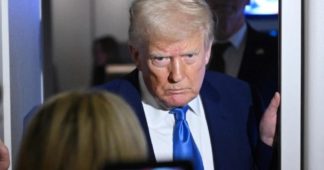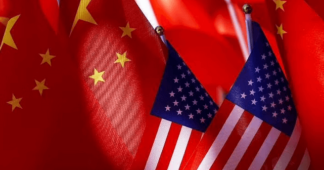By Nick Beams
April 9, 2025
The announcement yesterday by US President Trump of a 90-day pause in the implementation of his so-called “reciprocal tariffs,” ostensibly to allow negotiations to take place, is another expression of the deepening economic and financial crisis of American imperialism and its state.
The move came amid growing signs that the entire financial system—in particular the US Treasury market—was just days or even hours away from a meltdown on the scale of the crises of September 2008 and March 2020, or potentially even greater.
In announcing the pause, Trump revealed the essential core of his tariff hikes by escalating the economic war against China—the world’s second-largest economy—which all factions of the US political establishment regard as an existential threat to American global hegemony.
Trump declared that, because China had retaliated against US tariff hikes, tariffs on Chinese goods would be raised to 125 percent “effective immediately.”
In an earlier period, such an economic blockade would have been recognized as an act of war.
While the “reciprocal tariffs” on all other countries are being temporarily suspended, the 10 percent tariff on all goods entering the US will remain in effect.
In the lead-up to the announcement, the selloff on global stock markets continued. Even more significant, however, was the selloff in the US Treasury market—a foundation of the global financial system—which drove yields sharply higher. This mounting financial turmoil was a key factor in Trump’s decision.
According to a person described as “close to the White House,” cited by the Financial Times:
Trump is fine with Wall Street taking a hit, but he doesn’t want the whole house to come down.
A number of factors were driving the mounting crisis in the Treasury market. Hedge funds and other major investors, reeling from cumulative losses in the stock market amounting to hundreds of billions of dollars, were facing margin calls from the banks—that is, demands to provide additional funds as collateral to maintain the credit lines essential to their operations.
As markets plunged, the only available source of additional cash was the sale of Treasury holdings. Had this continued, it could have triggered a panic on the scale of March 2020, when the Treasury market froze and the US Federal Reserve intervened, injecting trillions of dollars into the system within days to restore stability.
It became apparent that foreign investors and governments—which hold roughly one-third of US Treasury bonds—were beginning to pull out of the market.
There were also signs that hedge funds were being forced to unwind their so-called “basis trades,” a strategy that profits from small differences between the price of Treasury bonds and their corresponding futures contracts. Because the price gap is minimal, these trades rely on massive leverage, with the total volume estimated at around $1 trillion.
Fears were emerging that China, the second largest holder of US Treasury bonds, could start to shift out of dollar assets in response to Trump’s economic war against it.
The dollar has been falling on currency markets, raising growing questions about how long it can maintain its role as the global reserve currency under conditions in which US policy is a major source of instability and uncertainty.
Summing up the worsening situation, longtime analyst Ed Yardeni remarked that the selloff of US Treasuries—usually considered a safe haven during periods of financial stress—was a sign that “the Trump administration may be playing with liquid nitro.”
Larry Summers, the treasury secretary under Clinton, said yesterday that the events of the previous 24 hours were a warning that a “serious financial crisis wholly induced by US government tariff policy” could be looming.
Following the announcement, Wall Street went into raptures. The NASDAQ jumped nearly 12 percent—its biggest one-day gain since 2008—while the S&P 500 rose by 9.5 percent, and the Dow surged 8 percent.
As with every action of the Trump administration, the events of yesterday were steeped in corruption and criminality. Just before the markets opened—and several hours before the public announcement of the “pause”—Trump posted on social media that “this is a great time to buy.” It will be left to future investigation to uncover how many billions were made by the Trump family and the gang of fascists operating in and around the administration.
Trump and his acolytes will claim that the growing number of countries now seeking negotiations on tariffs—and his erratic, on-again, off-again methods—are proof of his supposed great skill in securing beneficial deals for American capitalism.
Nothing could be further from the truth. Trump’s gyrations are not signs of strength but the personified expression of the deepening crisis of American imperialism and its state, for which he has no solution.
Government debt stands at $36 trillion and is rising daily, on a trajectory universally acknowledged as “unsustainable.” Interest payments alone are approaching $1 trillion annually and are rapidly becoming the single largest expenditure in the US budget.
The trade deficit is running at around $1 trillion, having increased by 17 percent over the past 12 months.
Domestically, consumer spending and confidence are both falling, and hundreds of millions of workers and their families face further reductions in their living standards as prices escalate on goods from China—which make up a large share of household consumption—due to the tariff hikes.
Business confidence is in tatters due to the uncertainty generated by the administration’s policies. A 90-day pause for negotiations with the dozens of countries targeted by “reciprocal tariffs” will do nothing to reverse this collapse. Recession is very much on the horizon.
No one knows what will come out of the talks. But the idea that countries like Vietnam, Thailand and Cambodia—as well as several impoverished African nations—could take any action capable of resolving the US trade deficit is ludicrous.
The major powers—such as Japan and the European Union—have no solution either. And no one, including Trump, has any idea what will happen after the “pause.”
There is one aspect of the “pause” that follows a clear logic. It is part of a broader drive to corral countries into a US-led global offensive against China. This is especially evident in Southeast Asia, where the economic threats directed at regional countries are aimed at pressuring them not to move closer to Beijing.
The message being delivered is: Align yourselves with the US on the key issue of “national security,” that is, the preparation for war against China, and make major concessions to the US not only on economic issues but on foreign policy as well or you will suffer the consequences.
The escalation of the tariff against China to historically unprecedented heights is the form through which this diktat is being delivered.
Trump’s actions yesterday have pulled the US back from a full-scale financial crisis that could have erupted as early as over the weekend. But what took place yesterday was not a resolution of the crisis but just a step towards the next one, which will take an even more explosive form.
This is because Trump’s so-called “liberation day,” April 2, was not a negotiation tactic but the destruction of what remained of the post-war international trading order. It cannot be put back together again. All the so-called “guard rails” put in place after 1945 to prevent the type of crisis which erupted in the 1930s and led to war no longer exist.
There is a madness in the policy of the Trump administration—but it is a madness with an objective basis. As it flails from one economic improvisation to the next, confronting a crisis for which it has no solution, the administration is carrying out a systematic assault on democratic rights and erecting the framework of a dictatorship in the United States. And whatever conflicts exist within the state apparatus, all factions are united in their determination to defend a capitalist system that is hurtling toward catastrophe.
Trump—the grotesque and criminal personification of American imperialism—along with the representatives of ruling classes in every country, will use the “pause” to coordinate their responses to international rivals and sharpen their weapons against the working class at home, in preparation for the eruption of class struggle they all fear and know is coming.
The international working class must soberly take stock of the events of the past week. The worst mistake it could make is to think that with the “pause” the crisis has somehow passed. It has not.
Accordingly, just as the capitalist ruling classes are making their preparations for what is to come, so must the working class, in the US and internationally. That preparation involves above all the political struggle for the program of socialism, as the only viable solution to the deepening crisis of the capitalist system that is so vividly on display.
Read also: China Fights Back and Raises Tariffs on U.S. Products to 84% | Defend Democracy Press
We remind our readers that publication of articles on our site does not mean that we agree with what is written. Our policy is to publish anything which we consider of interest, so as to assist our readers in forming their opinions. Sometimes we even publish articles with which we totally disagree, since we believe it is important for our readers to be informed on as wide a spectrum of views as possible.











